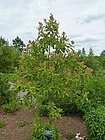Note: This is a project under development. The articles on this wiki are just being initiated and broadly incomplete. You can Help creating new pages.
Difference between revisions of "Persea borbonia - Redbay"
(→External Links) |
(→List of Ayurvedic medicine in which the herb is used) |
||
| Line 47: | Line 47: | ||
==List of Ayurvedic medicine in which the herb is used== | ==List of Ayurvedic medicine in which the herb is used== | ||
| − | |||
==Where to get the saplings== | ==Where to get the saplings== | ||
Revision as of 14:53, 11 June 2019
Persea borbonia is a species of plant in the Lauraceae family. It is one of about 150 species in the evergreen tree genus Persea. It is an evergreen tree that is native to the Southeastern United States.
Contents
- 1 Uses
- 2 Parts Used
- 3 Chemical Composition
- 4 Common names
- 5 Properties
- 6 Habit
- 7 Identification
- 8 List of Ayurvedic medicine in which the herb is used
- 9 Where to get the saplings
- 10 Mode of Propagation
- 11 How to plant/cultivate
- 12 Commonly seen growing in areas
- 13 Photo Gallery
- 14 References
- 15 External Links
Uses
fevers, headaches, Excess thirst, constipation, appetite loss, blocked urination, rheumatic joint, Diarrhea, painful limbs
Parts Used
Chemical Composition
Contains volatile oils, flavonoids, apigenin, luteolin, quercetin, kaempferol, tiliroside, triterpene glycosides including euscapic acid and tormentic acid, phenolic acids, and 3%–21% tannins[1]
Common names
| Language | Common name |
|---|---|
| Kannada | |
| Hindi | |
| Malayalam | |
| Tamil | |
| Telugu | |
| Marathi | NA |
| Gujarathi | NA |
| Punjabi | NA |
| Kashmiri | NA |
| Sanskrit | |
| English | Redbay, tisswood |
Properties
Reference: Dravya - Substance, Rasa - Taste, Guna - Qualities, Veerya - Potency, Vipaka - Post-digesion effect, Karma - Pharmacological activity, Prabhava - Therepeutics.
Dravya
Rasa
Tikta (Bitter), Kashaya (Astringent)
Guna
Laghu (Light), Ruksha (Dry), Tikshna (Sharp)
Veerya
Ushna (Hot)
Vipaka
Katu (Pungent)
Karma
Kapha, Vata
Prabhava
Habit
Identification
Leaf
| Kind | Shape | Feature |
|---|---|---|
| Simple | Alternate | The leaves are entire margins, lance-shaped, evergreen, 3 to 7 inches long, 1 to 2 inches wide |
Flower
| Type | Size | Color and composition | Stamen | More information |
|---|---|---|---|---|
| Unisexual | 2-4cm long | yellow-green | 5-20 | light yellow-green occurring in small, clusters in leaf axils |
Fruit
| Type | Size | Mass | Appearance | Seeds | More information |
|---|---|---|---|---|---|
| round drupe | 1/3 to 1/2 inch | mature in early fall | Dark blue | - | {{{6}}} |
Other features
List of Ayurvedic medicine in which the herb is used
Where to get the saplings
Mode of Propagation
How to plant/cultivate
Sandy to rich moist soils of low woodlands, coastal forests, along the sides of bogs, streams and swamps. Sometimes found in dry sandy areas in Florida.[3]
Commonly seen growing in areas
Sandy to rich moist soils, coastal forests, along the sides of bogs.
Photo Gallery
References
External Links
- Ayurvedic Herbs known to be helpful to treat fevers
- Ayurvedic Herbs known to be helpful to treat headaches
- Ayurvedic Herbs known to be helpful to treat Excess thirst
- Ayurvedic Herbs known to be helpful to treat constipation
- Ayurvedic Herbs known to be helpful to treat appetite loss
- Ayurvedic Herbs known to be helpful to treat blocked urination
- Ayurvedic Herbs known to be helpful to treat rheumatic joint
- Ayurvedic Herbs known to be helpful to treat Diarrhea
- Ayurvedic Herbs known to be helpful to treat painful limbs
- Herbs with Leaves used in medicine
- Herbs with common name in English
- Habit - Herb
- Index of Plants which can be propagated by Seeds
- Index of Plants which can be propagated by Cuttings
- Herbs that are commonly seen in the region of Sandy to rich moist soils
- Herbs that are commonly seen in the region of coastal forests
- Herbs that are commonly seen in the region of along the sides of bogs
- Herbs
- Ayurvedic herbs that don't have flower, fruit and leaf photos
- Ayurvedic herbs that don't have seed photos
- Lauraceae






